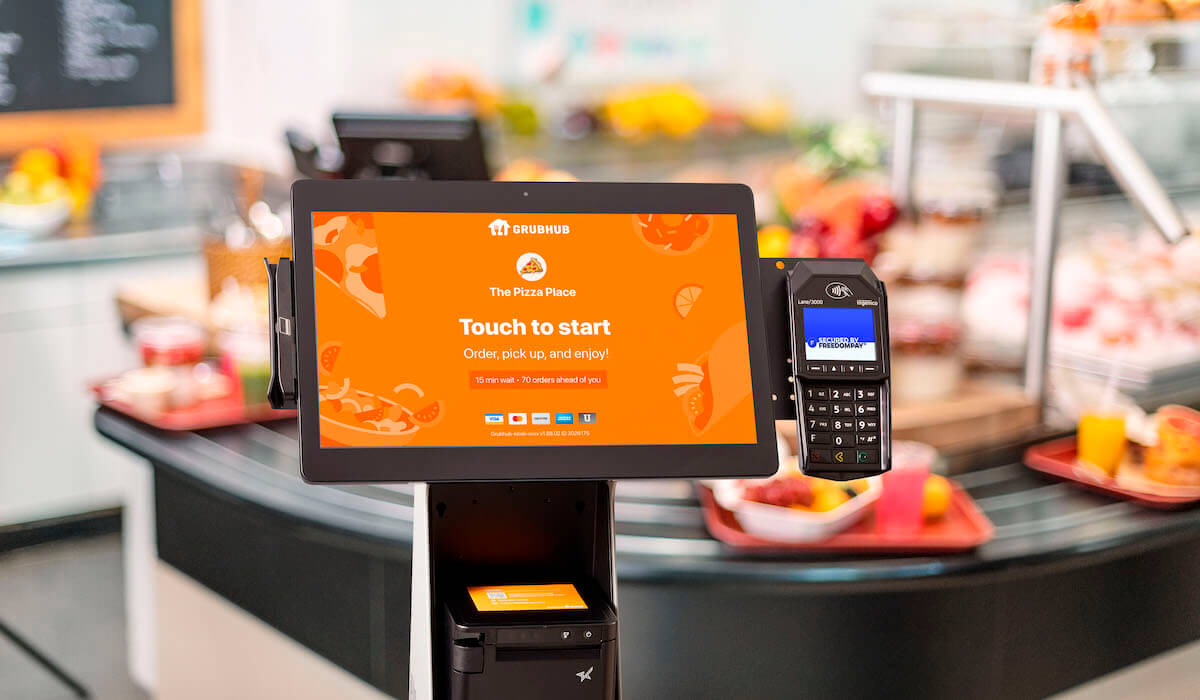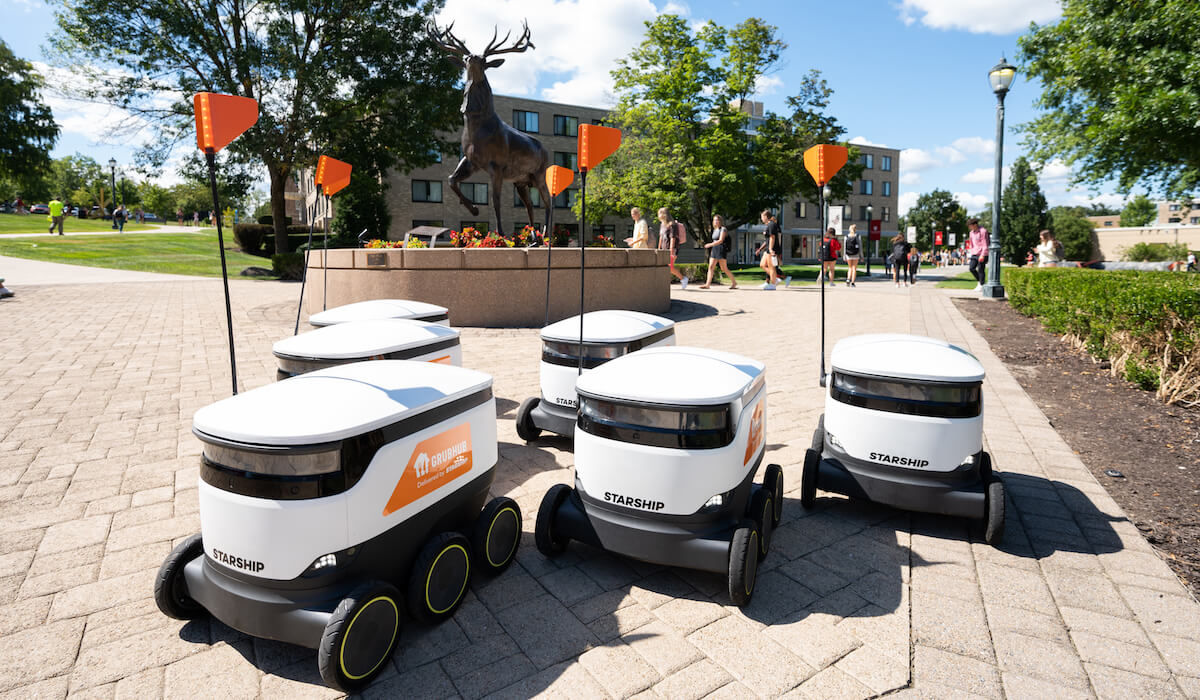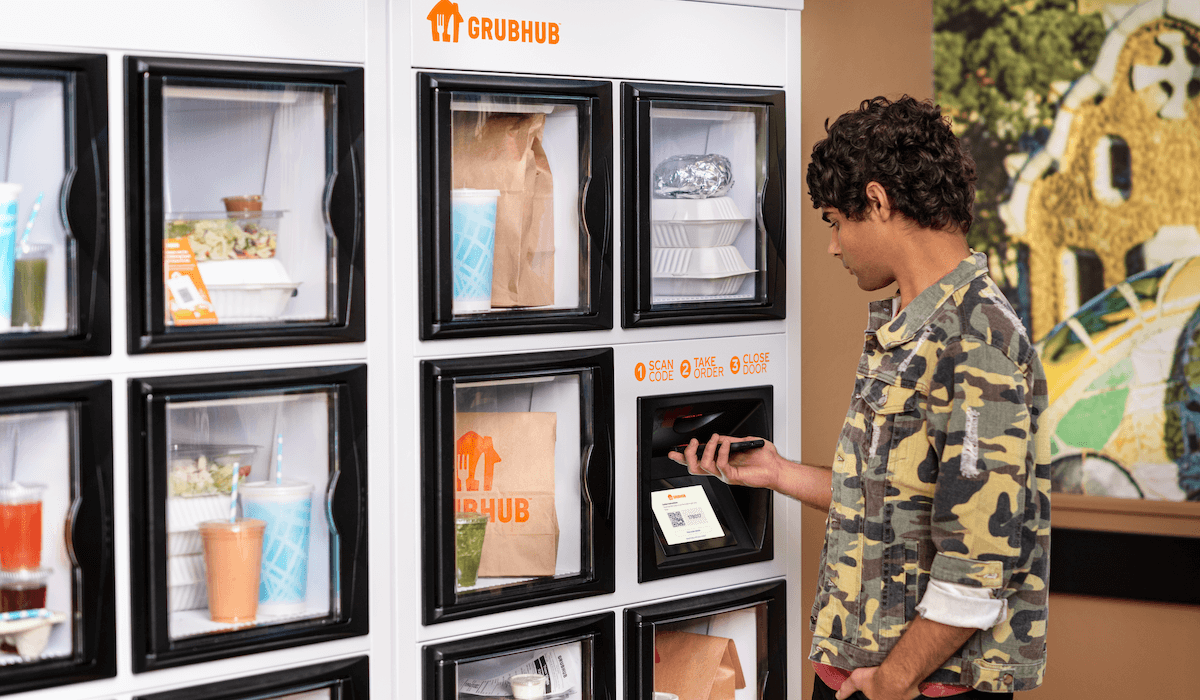Since 2020, the restaurant industry has been adopting new technology at an unprecedented pace. As a result, customers have grown accustomed to convenient ordering options and fast payments. If you’re looking for ways to add even more flexibility to your on-campus restaurant, self-service kiosks could be an ideal solution.
What is a self-service kiosk?
A self-service kiosk is a touchscreen device that enables customers to place orders and pay for their food at a restaurant. Each order is tagged with a name or number; once the meal is ready, it’s delivered to the counter for pickup. Most kiosks accept only cards or contactless payments. Some kiosks, such as Grubhub’s, can even accept campus tender.
These digital devices are most common at fast-food and fast-casual restaurants that offer counter service. Depending on the available space, a kiosk may be a large freestanding unit or a small, counter-mounted device that looks like a tablet.
If you operate a restaurant on a college campus, you can use self-service kiosks for both dine-in and takeout meals. That way, students and faculty members don’t need to wait in line or interact with employees.
How to implement self-service kiosks at your on-campus restaurant
Thinking about adding a self-service kiosk to your campus restaurant? Take time to consider how implementation works. When you understand the process, it’s easier to budget, select a device, and plan for a smooth installation.
1. Choose a technology partner
As you choose a self-service kiosk, look for options that are compatible with your current POS system and restaurant software. Alternatively, you can switch your entire operation to a new platform to save time and create a more seamless experience for employees.
If you’re already using Grubhub for delivery or online ordering, Grubhub On Site kiosks are a natural fit. They connect directly to the Grubhub platform, so you can connect them to your system with minimal interruption or training. Each kiosk communicates with your back-of-house staff using GrubhubTV kitchen displays and printers.
Grubhub On Site can also help you future-proof your operations. The service comes with access to special partnerships that make it easy to expand to food lockers, self-driving robots, and other cutting-edge options.
2. Select a location
Determine where you want to install each self-service kiosk. Look for a location that:
- Doesn’t block the counter
- Allows elbow room
- Creates space for other customers to line up
Ideally, your self-service kiosks will be located away from the pickup area. That way, customers can flow from one point to another without crowding your lobby area.
3. Install and set up self-service kiosks
Once your kiosks arrive, you must install them and connect them to your ordering system. This process varies by manufacturer. For example, Grubhub On Site kiosks plug into a standard 120-volt outlet; they also need an internet connection. Depending on your existing technology stack, you might also need to install kitchen monitors and printers.
The time it takes to set up your self-service kiosks depends on a range of factors, including the installation style. Freestanding and countertop kiosks usually offer faster setup than wall-mounted models. Additionally, you’ll spend less time if you choose a compatible technology product that requires minimal configuration; these products also reduce training time for employees.
After you connect the kiosk, you’ll need to set up the menu. Plan to spend at least a day adding menu items, customizing options, and uploading photos. In some cases, you may be able to import this information from your online ordering system to save time.
4. Test and launch
Put your kiosks through a rigorous testing process. Try ordering every menu item, customizing dishes, and selecting dine-in or takeout options. Make sure every change is communicated accurately to the kitchen. Test out the payment processor to ensure it runs smoothly for both cards and contactless options.
Get your employees involved; the firsthand experience will allow them to help customers. As soon as you’re confident the kiosks are fully operational and bug-free, open them up for customer self-service.
Self-service kiosk best practices
Used effectively, self-service kiosks can increase revenue and improve the ordering experience. A simple set of best practices can help maximize your return on investment:
- Leave plenty of space for customers. No one likes to feel crowded, so ensure your interactive kiosks allow room to breathe. A little extra room also allows two people to view the menu at the same time.
- Accept traditional cards and contactless payments. Speed is important to college students, especially when they’re on the go. When you choose a kiosk that accepts tap payments, customers can pay for their orders with a smartphone or smartwatch. With Grubhub On Site, you can even accept campus dining-plan cards.
- Build anticipation. In the days or weeks leading up to your kiosk installation, use signs and social media posts to let students know something exciting is coming. That way, everyone knows to keep an eye out for the kiosks.
- Communicate during the launch. When you first launch a kiosk, position a staff member nearby. They can draw customers’ attention to the new technology, explain the benefits, and be on hand to answer questions about each order. Also be sure to have signage with instructions for when a staff member is not available.
Benefits of using a self-service kiosk at colleges
Installing a self-service kiosk is an investment. As you decide whether this automated ordering solution is a cost-effective choice for your restaurant, it may help to consider the pros and cons.
The benefits of self-service kiosks for campus restaurants include:
- Satisfaction. When catering to a college crowd, self-service kiosks can help you attract more business. Younger diners tend to prefer self-service options—a 2022 survey showed that Gen Z customers are more likely than other demographics to like QR code ordering and food-delivery apps. What’s more, 40% of people in this age group believe restaurants should implement more types of technology.
- Convenience. A kiosk helps students and faculty members get their food faster, which is critical on a busy college campus, especially for people with a limited amount of time between classes.
- Reduced labor costs. The more orders that go through a kiosk, the fewer cashiers you need. Lower staffing requirements cut payroll costs and help you maintain operations even during labor shortages.
- Higher order accuracy. When a customer can input their own order, they aren’t relying on an intermediary to get the details right. This helps you reduce the number of ordering errors and boost overall satisfaction.
- Easy personalization. Self-service kiosks make it easy for guests to log in to a loyalty program using a QR code or phone number. Once they’re signed in, you can deliver a personalized experience by offering coupon codes or providing recommendations based on past orders.
If you decide a self-service kiosk is the right fit for your campus restaurant, Grubhub On Site can help. Each kiosk installs quickly and connects to the Grubhub platform, so it minimizes disruption to your operations—that way, you can continue providing efficient service to hungry college students. To find out more, get in touch.





